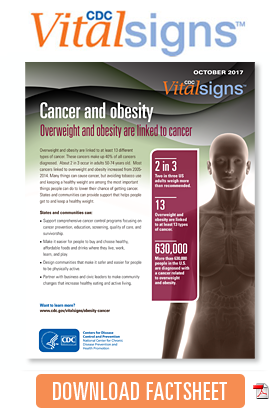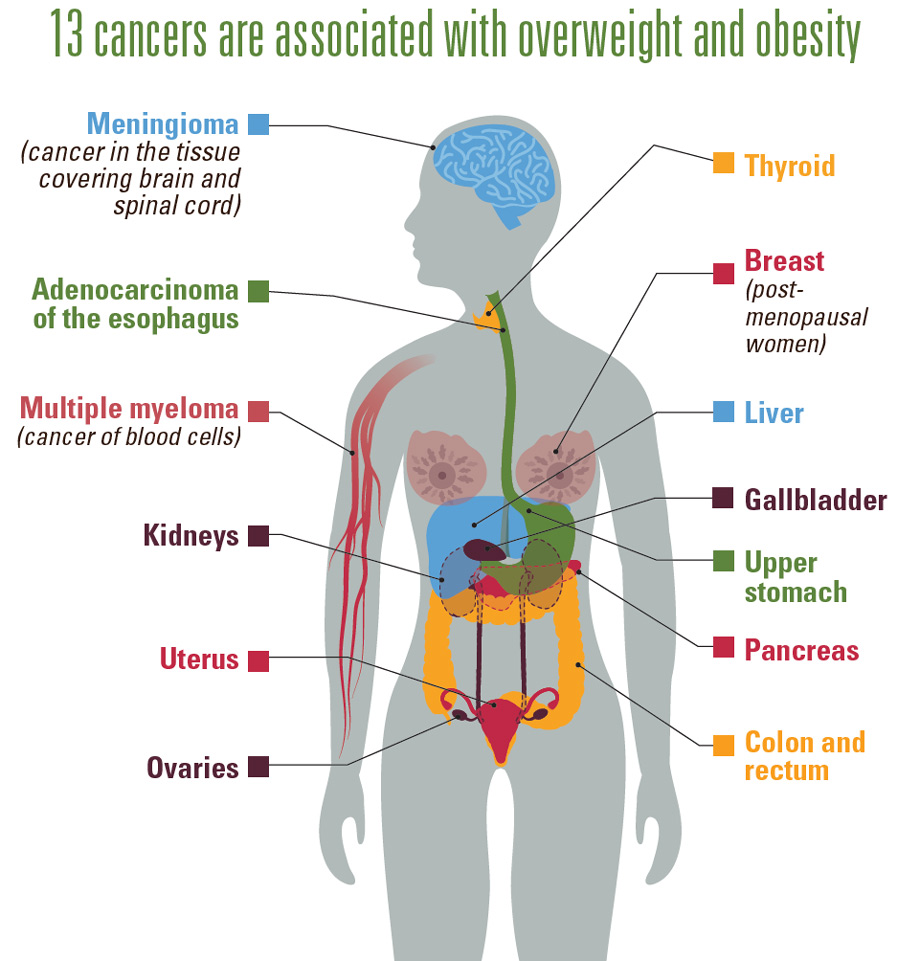Vital Signs: Cancer and obesity
Overweight and obesity are associated with cancer
Overweight and obesity are associated with at least 13 different types of cancer. These cancers make up 40% of all cancers diagnosed. About 2 in 3 occur in adults 50-74 years old. Most types of these cancers associated with overweight and obesity increased from 2005-2014. More than half of Americans don’t know that overweight and obesity can increase their risk for cancer. Many things are associated with cancer, but avoiding tobacco use and keeping a healthy weight are among the most important things people can do to lower their risk of getting cancer. Some states and communities are providing support that can help people get to and keep a healthy weight.
Some states and communities are:
- Supporting comprehensive cancer control programs that focus on cancer prevention, education, screening, quality of care, and survivorship.
- Making it easier to choose healthy food options where people live, work, learn, and play.
- Building communities that make it safer and easier for people to be physically active.
- Partnering with business and civic leaders to make community changes that increase healthy eating and active living.

Two in three US adults weigh more than recommended.
Overweight and obesity are associated with at least 13types of cancer.
More than 630,000 people in the U.S. are diagnosed with a cancer associated with overweight and obesity.
Obesity is a leading cancer risk factor.
What’s happening?
- A higher proportion of Americans are overweight or have obesity than several decades ago. http://bit.ly/2wViN5E
- Overweight and obesity can cause changes in the body
that lead to cancer, such as increases in levels of certain hormones and inflammation. - People who weigh more than recommended may increase their risk of some cancers.
- There are 13 types of cancer associated with overweight and obesity.
- About 55% of all cancers diagnosed in women and 24% of those diagnosed in men.
- About 2 in 3 of all cancers occur in adults ages 50 to 74.
- New cancer cases are higher among blacks and whites compared to other race and ethnic groups.
The Federal government is
- Funding programs in states and communities to promote healthy eating and physical activity.
- Studying what works in communities to make it easier for people to be more physically active and have a healthier diet.
- Measuring trends in cancer, obesity, and related risk factors.
- Developing and promoting guidelines on the dietary patterns and amounts of physical activity Americans need for good health.
http://bit.ly/2vFen14, http://bit.ly/2h4TWUJ
Some states and communities are
- Supporting comprehensive cancer control programs that focus on cancer prevention, education, screening, quality of care, and survivorship.
- Making it easier to choose healthy food options where people live, work, learn, and play.
- Building communities that make it safer and easier for people to be physically active making it easier to choose healthy food options where people live, work, learn, and play.
- Partnering with business and civic leaders to make community changes that increase healthy eating and active living.
Healthcare providers can
- Measure patients’ weight, height, and body mass index, and counsel them on keeping a healthy weight and its role in cancer prevention. Weight Loss to Prevent Obesity-Related Morbidity and Mortality in Adults
- Refer patients with obesity to intensive programs that include a variety of activities
to help people manage their weight. - Connect patients and families with community services to help them have easier access to healthy food and ways to be active.
Everyone can
- Eat a healthy diet by following the 2015-2020 Dietary Guidelines for Americans.
http://bit.ly/2vFen14 - Do at least 150 minutes of moderate intensity physical activity, such as brisk walking, every week. http://bit.ly/2h4TWUJ
- Talk to their healthcare provider about losing weight or maintaining a healthy weight.
- Get involved in community efforts to improve options for healthier foods and physical activity.
- Lose weight, if they weigh more than recommended, to help reduce risk for some cancers and other chronic diseases.




